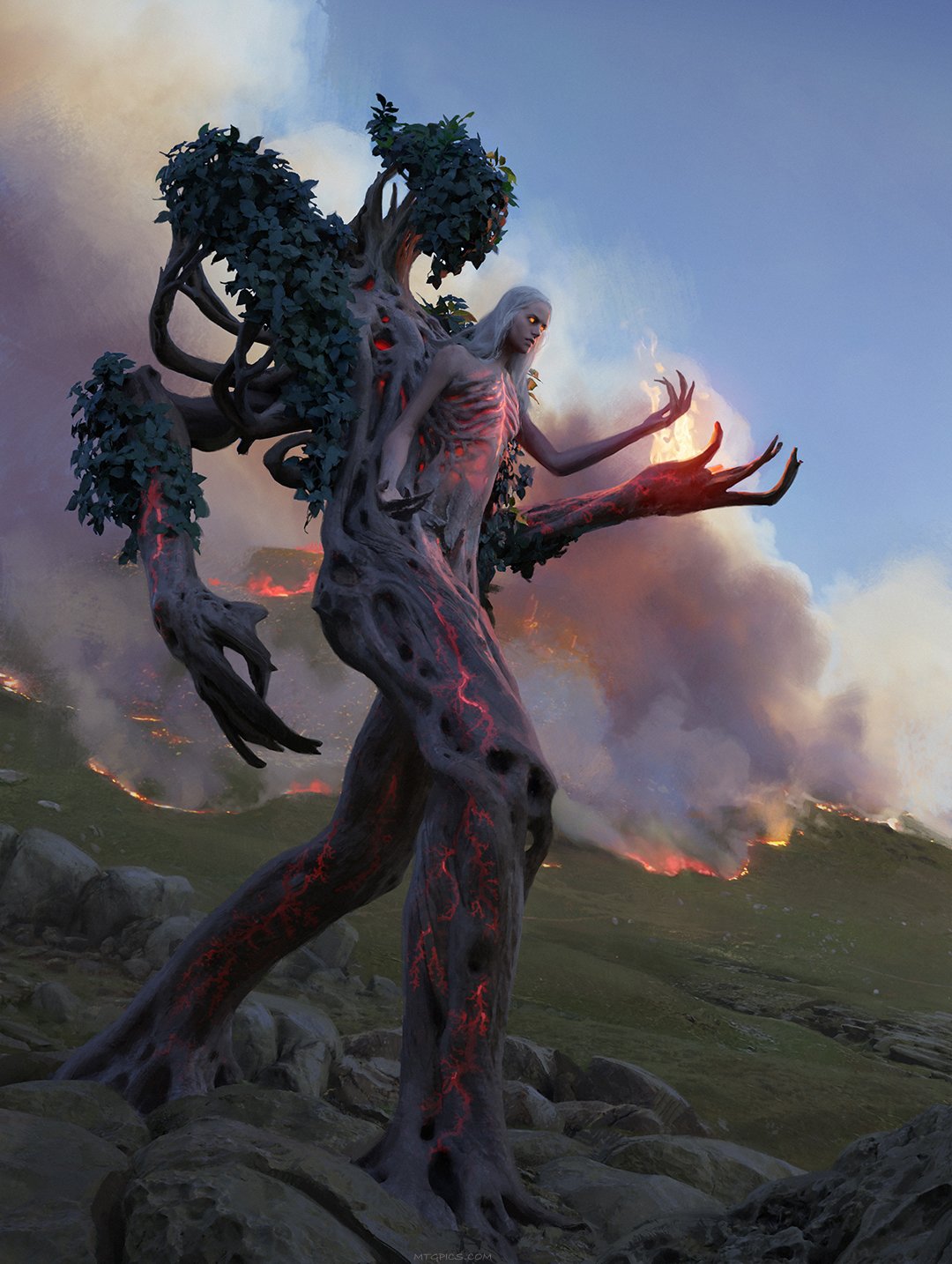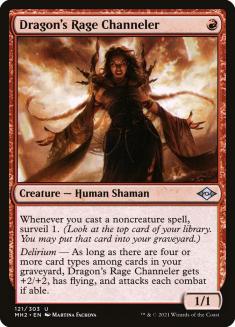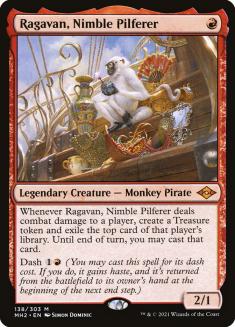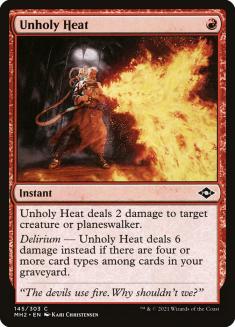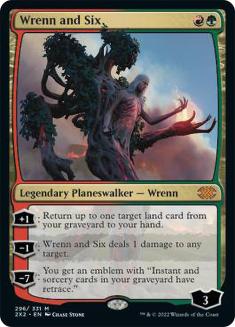There’s no doubt about the impact Modern Horizons 2 has had on Modern. We’re over a month in and the metagame has completely changed. Even Amulet Titan and Asmor decks, once among the most popular and successful archetypes, have faded into relative obscurity.
Undoubtedly more changes will come, but some definite trends indicate a fundamental reshaping of the principles governing the Modern format. Understanding the new principles is critical in understanding where the metagame is moving. I firmly believe that that direction points to Wrenn and Six being incredibly well-positioned.
The Red Triumvirate
These changes largely stem from the rise of a new trio of red cards: Dragon’s Rage Channeler; Ragavan, Nimble Pilferer; and Unholy Heat. They’ve led to a proliferation of different midrange strategies, largely in the Grixis spectrum of colors. But along with Lightning Bolt, these are the core cards. The rest is mere window dressing.
But just why have these cards proven so powerful? After all, both Ragavan and Dragon’s Rage Channeler are one-mana creatures that die to plenty of commonly played removal spells. And Unholy Heat is another one-mana removal spell among many. What makes these cards particularly strong?
For the two threats, the answer is a matter of risk versus reward. Both Dragon’s Rage Channeler and Ragavan generate a cascading advantage if left unanswered. Channeler does so through card selection via surveil, and Ragavan via the mana and card advantage generated whenever it connects. Eventually, these advantages accumulate to something that swings an entire game, so they’re must-answer threats.
That kind of reward is typical of more expensive creatures, but rare to see for one mana. And that’s because at one mana, it’s a much smaller investment of resources, and thus a lower risk. The worst-case scenario when you cast Ragavan or Dragon’s Rage Channeler on Turn 1 is that your opponent answers it on their turn with a one-mana removal spell. That’s an even exchange of resources: one mana and one card for one mana and one card. Channeler may even give you a surveil trigger if you have a Mishra’s Bauble to come out slightly ahead.
For more expensive creatures, an exchange for a one-mana removal spell may be even on cards but not on tempo. Come out on the wrong side of enough of those exchanges and you’ll find yourself hopelessly behind on the battlefield.
Opponents can defend against these threats by playing bigger creatures, but that’s where Unholy Heat comes in. An efficient removal spell that’s also versatile enough to answer bigger creatures and planeswalkers lets you press any early advantage gained by your cheap threats. Previously you’d have to dip into another color for Fatal Push, which doesn’t answer planeswalkers or expensive creatures like Primeval Titan, or Path to Exile, which is a poor answer in the early-game. With Unholy Heat covering the cards missed by Lightning Bolt, these decks are a lot more flexible. That’s how you stay on top of the metagame week after week.
Unless a deck is completely broken, there will always be ways to combat it. Still, if a deck is flexible, you can always adapt to your new opponents and find ways to stay ahead. The more flexible your deck is, the more easily you can adapt, and the more successful you’ll be week-to-week.
With Lightning Bolt and this new trio of red cards, Modern has reached a critical mass of efficient threats and removal, making the interactive midrange decks almost impossible to combat in the long-term. On any given weekend there’s a hole in the lists that you can exploit, but they’ll always plug that hole. That’s why you see the rest of the metagame dominated by powerful linear strategies like Mono-White Hammer (Lurrus) and Living End. They can just overpower the fair decks and not worry about winning a back-and-forth, interactive game.
This critical mass of efficient threats and removal has diminished the effectiveness of more expensive threats. Cards like Primeval Titan and Teferi, Hero of Dominaria that previously matched up well against midrange decks are now so efficiently answered that even if you get a couple of lands or an extra card, you won’t have enough time to leverage them since you’re so far behind on the battlefield.
Even Mono-Green Tron decks can’t go over the top against the advantage Ragavan and Dragon’s Rage Channeler generate. If you want to succeed in Modern these days, you need to lower your curve to keep up.
Planning for the Late-Game
With the race to lower the curve and the ineffectiveness of expensive, game-dominating threats, the major question remaining is how to win long games. With everyone playing a pile of cheap removal, there will be plenty of games where resources trade off early, leaving players looking to the tops of their decks for an edge. But those saving-grace planeswalkers and large creatures aren’t coming anymore.
In the new Modern of more mana-efficient decks, the long game belongs to the player who grinds it out with cheap two-for-ones. It’s actually more of an old-school card advantage game, an era where those powerful threats didn’t exist yet. We’re seeing a return of cards like Kolaghan’s Command, which also matches up well against Colossus Hammer. Or cards like Snapcaster Mage, which plays well in a format defined by cheap spells. And even newer cards like Expressive Iteration.
Finding the right balance between cheap answers and threats and these slightly more expensive card advantage spells can be difficult, and it’ll change every week based on metagame fluctuations, but that’s the deckbuilding challenge at the moment. Even the linear decks are playing it, like Mono-White Hammer and the choice between Ingenious Smith and Giver of Runes. Or the more efficient Springleaf Drum and Paradise Mantle, which can cantrip when you have Puresteel Paladin.
The Best of Both Worlds
Under this new paradigm, the goal is to find threats that can generate card advantage yet are cheap enough to not consistently put you behind on tempo in the face of Unholy Heat and the other cheap removal spells in the metagame. And I think the answer is Wrenn and Six.
At two mana, you can afford to lose Wrenn to an Unholy Heat without falling behind; moreover, you’ll likely have an extra land to show for it. Even better, Wrenn can take out a Ragavan or a non-delirious Dragon’s Rage Channeler. But if left unanswered, Wrenn absolutely can take over a game. Making every land drop ensures that you don’t fall behind early. Later on you can start turning those land drops into extra cards with Horizon or cycling lands, and the ultimate ability is absolutely game-winning.
Right now, you almost exclusively see Wrenn and Six in the Jeskai Taking Turns deck or Four/Five-Color Control. Ari Lax wrote about these decks and the power of the tandem of Wrenn and Six and Teferi, Time Raveler earlier this week. While I do think these are solid decks, they aren’t the only potential homes for Wrenn and Six. It should be a fixture of midrange decks as well.
I’m not the only one who thinks this, as evidenced by a pair of decklists from last weekend’s Modern Challenge. First is a Jund list:
Creatures (14)
- 4 Tarmogoyf
- 2 Kroxa, Titan of Death's Hunger
- 1 Tourach, Dread Cantor
- 3 Ragavan, Nimble Pilferer
- 4 Dauthi Voidwalker
Planeswalkers (3)
Lands (22)
Spells (21)

You don’t need to go too far with green cards since the pickings are pretty slim. But with such a diverse range of card types, Tarmogoyf starts to look pretty good. There are few Fatal Pushes around to answer it cleanly. It’s easy to imagine it getting to 6/7 and surviving Unholy Heat. I know Jund purists would like to see Bloodbraid Elf again, especially in a world where you want clean two-for-ones, but that’s not happening with Lurrus of the Dream-Den around, so just keep those in your Jund boxes for now.
While appropriately light on green cards, I do think this list goes too far on two-mana threats, especially with Dreadbore and Assassin’s Trophy taking up removal slots in order to answer Murktide Regent. I’d prefer to see the deck move in a more streamlined direction and take advantage of Dragon’s Rage Channeler. Here’s my proposed list:
Creatures (14)
Planeswalkers (3)
Lands (22)
Spells (21)

This list raises the count of cards with mana value one from fourteen to 21. This major reduction in the curve involved cutting Dauthi Voidwalker entirely, so I compensated by adding an additional piece of graveyard hate to the sideboard. To go even further, I’d consider playing Abundant Harvest and lowering the land count, thus making your Dragon’s Rage Channelers even better, but the success of Rakdos Midrange shows that’s not necessary.
I also believe that in this era of low curves, Inquisition of Kozilek is significantly better than Thoughtseize, so you should play four copies of the former whenever possible. That said, discard overall is weaker in a format where players are forcing you to react to the battlefield on Turn 1, so I went down to five copies in the maindeck and the sixth in the sideboard for slower matchups.
I like the balance here between one-mana spells and more expensive spells that generate card advantage, as well as the balance between various types of disruption. Tasha’s Hideous Laughter may be more of a problem now, but I’ll take that in exchange for matching up better in midrange mirrors.
The other option for Wrenn and Six midrange decks is to dip into blue for counterspells and other sources of card advantage. Such a Temur deck also showed up in last weekend’s Challenge:
Creatures (16)
Planeswalkers (2)
Lands (18)
Spells (24)

You can’t spend too much time casting cantrips in Modern these days because of how much pressure you’re under from the start, but Abundant Harvest’s reliability makes it a real option. It helps you keep hitting your land drops and you can often pair it with a cheap removal spell or threat to ensure that you’re not falling behind on the battlefield. That reliability lets you then trim your land count, which effectively generates card advantage over long games. Eventually your opponent will naturally draw more lands, and you’ll be up a spell or two.
I also appreciate the discipline in playing only two copies of Counterspell. Much like discard spells, counterspells get weaker as the format plays out faster; once you’re behind they won’t help you catch up. And since they are generally more expensive, you just can’t play many. I’d rather go down to one than up to three, for example.
If you want to go the Temur route, here’s the list I’d play:
Creatures (16)
Planeswalkers (3)
Lands (18)
Spells (23)

Not many changes, but I do favor Tarmogoyf over Murktide Regent in the split of big creatures. The latter has high diminishing returns, especially when you’re trying to maintain delirium for Dragon’s Rage Channeler. A few weeks ago when players were unprepared to answer the flyer it would’ve been a different case, but now I’ll go with the classic creature.
I wanted to cut the Brazen Borrower too, but you absolutely need your own answers to Murktide Regent. Bouncing it is about as good as it gets for Temur decks. It’s possible you’d rather have a second copy of Seal of Removal so you have more enchantments for Tarmogoyf and delirium, but I like diversity in my flex spots, and you shouldn’t feel that compelled by such minor synergies.
To that end, I cut the Tarfire to make room for a third Wrenn and Six. This maintains the additional answer to cheap creatures. I’m bullish enough on Wrenn to risk having a slightly higher curve.
This deck doesn’t have the flexible removal of Jund, but it has more card advantage to take over the late-game. I’d be more worried in the Mono-White Hammer matchup, but I’d take Temur in the matchup against Jund.
Win and Six
In a world where Jace, the Mind Sculptor doesn’t make the cut anymore, Wrenn and Six is the game-winning planeswalker you need. It won’t put you behind early, offers immediate impact against an early threat or an empty battlefield, and is a must-answer threat that will win the game if left around for too long. It checks every box and deserves a greater role in the Modern metagame.
I know Grixis is the flavor of the month right now, but I expect green cards to make a comeback in Modern soon. When that happens, it’ll be behind the power of Wrenn and Six more than anything else.

